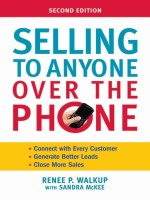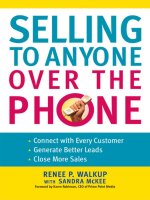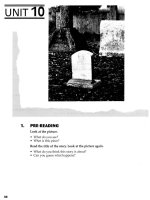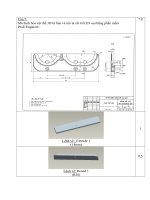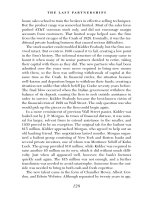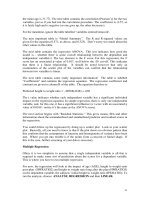Selling to Anyone Over the Phone phần 5 docx
Bạn đang xem bản rút gọn của tài liệu. Xem và tải ngay bản đầy đủ của tài liệu tại đây (128.95 KB, 20 trang )
69Getting Gatekeepers to Work for You
Salesperson: Angela, I’m sure you’re very busy. (Pause here just a
second or two to see if Angela wants to tell you how busy she is.)
Gatekeeper: Why, as a matter of fact, I am. Tracking my boss’s paper-
work for travel expenses takes a lot of my time over and above my
regular work!
Salesperson: I can understand. Our company has some really easy-
to-use software that even your boss might feel comfortable with.
Would that help you at all?
You see, just the fact that you acknowledged the duress many
receptionists and assistants are under will differentiate you from other
callers who treat them like a PBX. It only takes a few seconds to be
supportive, and support is always welcome, unlike flattery. Later, in
that call or other calls, you can likely expect a cooperative reception.
For example, let’s say you are returning a call from a customer
and reach a receptionist.
Salesperson: Keisha! Michael called me earlier. I’m trying to reach
him, and I hope you can help me out. He said to call him at 10:00,
but I haven’t been able to reach him. Do you mind paging him, or
should I call this afternoon?
In this scenario the gatekeeper might feel sorry for you, appreci-
ate your honesty, and find the contact for you or give you a better
number—cell or other location. As a sales professional, you can dif-
ferentiate yourself from others who call and aren’t professional.
A note here about formality is important. In other chapters, you
have read that the more formal approach is better, meaning to call a
person by Mr. or Ms. and use the surname. With receptionists and
administrative assistants, however, we often only have their first
name. They may answer the phone with, ‘‘Alexander Courtney’s of-
fice, this is Pat.’’ Or even say, ‘‘This is Kevin.’’ Thus, calling Pat or
Kevin by a first name would not likely be perceived as being too famil-
iarorunprofessional.
PAGE 69
11375$ $CH4 06-02-05 12:01:19 PS
70 Selling to Anyone Over the Phone
Exercise: Check your call frequency to gatekeepers.
Activity: Take a few moments to write down some strategies
to deepen your calling relationship with each of the gatekeep-
ers in your contact list. Call more often? Involve more in deci-
sion questioning? Affirm in a more professional way?
E-Mail as a Gatekeeper
Your customer may have an assistant who serves as a screener for
e-mails to save time for a high-level decision maker. To avoid e-mails
that look like spam, make your subject lines intriguing, compelling,
and professional, not too wordy. Obviously, you never leave a subject
line blank. If you do, the spam filter will delete the e-mail or the
customer will.
Faxes
You may decide to call or send an e-mail with the basic information,
then fax the documents themselves. You might have better control
over how your logo, formatting, and typeface look. Also, since faxes
are not used with the frequency they once were for general contacts,
they are often delivered right to the desk of the intended person.
The Payoff
Getting to customers is one of the biggest challenges of phone sell-
ing. Learning to manage gatekeepers as well as other obstacles such
as alternate contact media will help you fast track to your contacts.
Once you get to your customers, you have the opportunity to do
whatyoudobest—sell to anyone over the phone.
PAGE 70
11375$ $CH4 06-02-05 12:01:20 PS
5
CHAPTER
Planning and Tracking
PAGE 71
11375$ $CH5 06-02-05 12:01:11 PS
PAGE 72
This page intentionally left blank
T
IME AND MUSIC.
How long is a song supposed to be? The radio
standard is typically three-and-a-half minutes for a song. The longest
number one song was ‘‘American Pie’’ by Don McLean, which
clocked in at nearly nine minutes. Album-length CDs can have longer
pieces, which are typically cut to fit the standard time if the song is
released for radio play. It is fortunate that Bach and Mozart did not
do their writing in the modern age of radio or the symphony might
have taken on a very different nature. The reasoning for shorter songs
is simple: Any time a song is playing, an advertisement is not on air.
Too many long songs would cut into a radio station’s ability to earn
its advertising money.
For professional salespeople, especially for commission sales, time
on the phone translates directly into money, while time not on the
phone takes away from that income. Ineffective time on the phone
can also spell loss in the long run. Planning, customer research, track-
ing customer information and accounts, and even skill enhancement
(such as reading this book) are all non-phone expenditures of your
time. When time is invested in perfecting your call-to-close ratios,
that is time well spent and pays off in large dividends. Too often sales
pros get lost in thinking they don’t have time to plan or do follow-
up tracking paperwork.
To learn what your time is worth, and to ascertain your value per
PAGE 73
73
11375$ $CH5 06-02-05 12:01:12 PS
74 Selling to Anyone Over the Phone
hour, minute, and year, look deeper into this chapter. You’ll probably
find that every minute invested in developing your sales skills is time
well spent; particularly if you work in commission sales.
Anything you do to improve your skills and effectiveness is a
good expenditure of your time. Endless dialing of the phone that
does not yield closed sales is not only a waste of time but also a waste
of your own money. This chapter is about managing your accounts,
and covers methods that will help you gather and utilize customer
informationsothatyourcallplanningleadsyoutomoreclosedsales.
Information to Be Gathered
You need to keep track of a great deal of information about your
customers. Since everyone’s company does this differently, this sec-
tion will be a guideline for what kind of information you need to
keep and which methods work best to store that information for easy
retrieval.
The following list shows the most essential information that’s
needed for easy retrieval:
Name
Title
Position
Phone extension
Mobile or alternative phone
Time zone
Fax
Address
Their Company Web site
Some sort of status designation is needed: customer, prospect,
referral, cold call, strategic partner, etc.
PAGE 74
11375$ $CH5 06-02-05 12:01:13 PS
75Planning and Tracking
Sales history
Products/services used
Customer since (year)
Service agreements y/n
Renewals
Lease expiration
Follow-up date
Assistant’s name/phone
Home phone
Personal interests—sports, organizations, or associations
Spouse name, children
Referred by
Personalitytype(
P, E, A, K)
Best times to reach
Competitors—direct and indirect
Notes or comments section—captured conversations, dates, dis-
cussions, etc.
Link to a proposal or sales agreement if applicable.
Company Records V Getting Leads
Your company’s intranet can tap you into forecasting programs, in-
ventory pages, online slide presentations, or even customer service.
These are good places to get leads. If your customer service personnel
are trained to address service situations as sales opportunities, access
to those records or personnel can lead to business for you. For ex-
ample, recurrent technical problems could mean that a better or
upgraded product would be appropriate. If a personal trainer has pur-
chased home-use equipment and trains many clients all day on the
equipment, he or she might be having problems with it, since it
wasn’t designed for such heavy use. For you, the salesperson, this
PAGE 75
11375$ $CH5 06-02-05 12:01:13 PS
76 Selling to Anyone Over the Phone
knowledge gained from customer service might lead you to suggest
commercial grade equipment, thus providing a valuable lead for you.
Take a look at who else in your company has opportunities to
uncover leads? Who are your customers’ employees contacting—such
as other divisions in your company or from the service department?
What might your boss or predecessor know about a customer? Per-
haps one of your business partners or vendors knows about a custom-
er’s situation. Trade show exhibitors and attendees are a valuable
source of information for many salespeople. Of course, you’ll want
to check the prospect’s Web site and use the Internet for additional
company or personnel information.
Do you know how decisions are made? Is the customer contact
person a gatekeeper, purchasing agent, or does this person make pur-
chasing recommendations?
As you can see, there is limitless information you can gather on a
customer from behind the scenes. You will need to decide what is
important, and more is often better. However, more information is
only useful if you can catalog and retrieve it in a timely and purposeful
way. The following approaches can help manage customer informa-
tion:
Your Record Keeping
Paper methods can include index cards, call report forms, or paper
files.
Advantages
▲ Whenyouactuallyholdapenorpencilandwritedowncus-
tomer information such as interests, needs, and more, you re-
tain the information for a longer term. Each time you process
any type of data, your long-term memory kicks in, where it is
easy to call back up.
▲ You might enjoy having hands-on control of keeping track of
customers.
▲ If you are a visual person, you can use a color system of files
or index cards for cataloging—past customers are pink, cur-
rent large customers are green, and so forth.
PAGE 76
11375$ $CH5 06-02-05 12:01:14 PS
77Planning and Tracking
▲ You can keep private any specific information that might not
be appropriate for a company database. If a customer is a col-
lector of baseball cards or refinishes furniture, you can keep
this information. Specific quotes from customers or personal
notes of yours about the personality or customer preferences
become your private property, not to be seen by all company
employees.
Disadvantages
▲ Individual pieces get lost.
▲ Paper/cards must be filed.
▲ Files, storage take up space.
▲ Information may not be easily transferable to someone else
who might need it (sales manager, another rep, customer ser-
vice).
▲ Management of hard-copy information can be time consum-
ing—collate, file, alphabetize.
▲ Paper records are heavy and bulky, especially where there are
many customers.
▲ Too much room exists for multiple errors (such as not being
able to read handwriting, misplacing information, running out
of space on a note card, etc.).
Electronic methods can include software, personal digital assis-
tants, and computers.
Many companies have their own database system that program-
mers adapt from existing software or create specifically for their own
company’s use. Others use off-the-shelf products. An electronic man-
agement system can be as minimal or robust as you prefer. Since there
is such a broad range of prices and applications, you should be aware
of what you actually need. An interior designer who has a small busi-
ness and must track fifty to one hundred clients might not want to
pay $350 for a robust system when a $100 system might hold and
track as much information as he or she needs.
Sometimes, though, less expensive software simply cannot handle
PAGE 77
11375$ $CH5 06-02-05 12:01:14 PS
78 Selling to Anyone Over the Phone
the load. (Customer contact manager software such as ACT!, Gold-
mine, Telemagic, and Salesforce.com are examples.) A recent search
on Yahoo yielded thirty-five listings of Customer Relationship Man-
agement (CRM) software. Many of these programs can be put onto
company networks, so your information technology manager might
need to be involved in your consideration of which to choose. You
can also find software that is compatible with personal digital assis-
tants (PDAs). Whatever you choose, you need to ensure that your
program is compatible with your hardware and software systems.
Advantages
▲ Established software systems for contact management have
been around long enough for you to expect reliability.
▲ Portable devices are easy to use and to connect with desktop
systems.
▲ Information is easily duplicated and backed up.
▲ You can keep records for a long time as a tracking and purchas-
ing history.
▲ Many are affordable for individual use.
▲ Databases allow you to use many different identifiers to locate
customers. For example, you might remember that a customer
likes Californian wines and that you met the person at a tele-
com conference, but you can’t remember the person’s name.
With a robust database, you’ll be able to find that individual
effortlessly.
▲ Data can be backed up regularly and easily to reduce the risk
of lost information.
Disadvantages
▲ You may not have remote access to your database.
▲ Desired software packages might be cost-prohibitive.
▲ Information technology department might not allow software
tobeaddedtonetwork.
PAGE 78
11375$ $CH5 06-02-05 12:01:14 PS
79Planning and Tracking
▲ The software fields might be too restrictive. For example, you
could find it useful to keep personality type recorded, yet the
software won’t allow added or edited fields.
▲ You might not have the staff or time to convert data—
transcription, scanning, etc.
▲ You could lose your PDA or handheld computer.
▲ A virus in your desktop computer or on your company’s net-
work could cause you to lose everything.
Whatever contact manager software you choose, be sure it is flex-
ible enough to allow you to create your own fields. One example
might be ‘‘I.D.’’ In this field, you could record how you know a cus-
tomer. Maybe you met this person at a conference, professional asso-
ciation meeting, school alumni party, or even at the gym or in a class/
seminar. This is also an ideal location to include a referral name so
that when you call the customer, you can use the referral name.
Sometimes, as part of planning, you will contact everyone you met
through a specific association or at a certain seminar. You can custom-
ize a phone or mail campaign based on an approach relevant to those
people in a particular organization.
You can also sort by fields to plan. In other words, you might
decide that you want to plan your day by contacting customers in a
particular time zone. Using your contact manager, you can call up
people in those areas. It is important to have a consistent system for
tracking what time you are to call, either their time or yours.
The way you are going to capture information isn’t as important
as the habit that you have created of gathering information and re-
cording it. Being consistent with your record keeping is a valuable
shortcut to your planning and follow-up.
Time/Cost Trade-Off
There are many ways to increase your efficiency as a sales professional.
None, however, are magical, nor do they work unless you use them.
For many of you, the recommendations in this chapter will be a sig-
nificant departure from ‘‘I’ve always done it that way.’’ The following
PAGE 79
11375$ $CH5 06-02-05 12:01:15 PS
80 Selling to Anyone Over the Phone
chart will help clarify why it’s so important to make changes that can
improve your efficiency.
First, find your annual income in salary. You’ll see to the right
what an hour of your time is worth, a minute, and last, in a year, if
you waste an hour a day, how much you have squandered in terms of
time (based on 244 days per year). If you are on a commission plan,
the numbers are even more dramatic, since there are wasted opportu-
nity costs by not being as efficient as possible and maximizing your
sales.
What is your time wor th?
This chart shows a breakdown of the $ value of your calling time.
Over a Year What an
Annual Income Hour Is Worth Minute Is Worth Hour a Day Is Worth
$40,000 $20.49 .34 $5,000
$50,000 $25.61 .43 $6,250
$75,000 $38.42 .64 $9,375
$100,000 $51.23 .85 $12,500
$125,000 $65.10 1.09 $15,884
$150,000 $76.84 1.28 $18,750
$175,000 $89.65 1.49 $21,875
$200,000 $102.46 1.71 $25,000
᭧SalesPEAK, Inc., all rights reserved, www.salespeak.com
So, the way you manage your time has a direct impact on your
income. If you are on straight commission, or receive bonuses, that
extra hour each day you might spend in the car running to customers’
sites sucks up more than gas money. This is another good argument
for making more use of the phone for your sales activity. Lost time
translates directly into lost money for you.
Now, let’s look at your day and see just where your time is spent.
PAGE 80
11375$ $CH5 06-02-05 12:01:15 PS
81Planning and Tracking
Exer cise : Wher e doe s the time g o?
For this exercise, you will need to track everything you do for
three days, rounding your activity to fifteen-minute incre-
ments. Let’s say you start your day at 8:00, then spend one
hour calling customers, then break for fifteen minutes, etc. Be
honest with yourself because no one will see this but you, and
its purpose is to help you make more money through greater
efficiency.
At the end of the three days, sit in a quiet room and care-
fully analyze this report to see how you are using your time.
Take a look at what you, personally, have control over.
Consider how you can make better use of your time in different
ways. After tracking your time, you might determine that by simply
starting your calls fifteen minutes earlier, which allows you to make
eight more calls per day or forty more per week, you can increase your
sales. This might lead you to close three more sales per week. If an
average sale for you is $1,000, in a week that adds up to $3,000,
which multiplied by fifty-two weeks equals an increase of $156,000
in sales per year!
8 additional calls/day V 40 more per week V
3 more closes per week @$1,000 V
$156,000/yr increase in sales!
If your commission is 10 percent, you’ve added $15,600 to your
yearly income. Is that chump change? The discipline part of this,
though, is that starting your telephoning just fifteen minutes earlier
gets you those additional eight calls per day. If you already spend that
extra fifteen minutes having coffee and reading the newspaper, you
have only deprived yourself of fifteen minutes of sleep.
The key is to examine what you do with your time. Although each
person is different, every sales professional can manage time more
effectively. In your plan, you might take every Friday afternoon off.
A colleague might see that as a waste of time. Yet, for you, that after-
PAGE 81
11375$ $CH5 06-02-05 12:01:16 PS
82 Selling to Anyone Over the Phone
noon might be networking time (an important part of lead genera-
tion), or it might be sanity preservation or exercise to stay healthier.
If you spend fifteen minutes every afternoon talking to your child
after school, that is not wasted time, even though it is a personal
call—it is peace of mind. When you remember what your time costs,
you are more aware of the cost/return ratio and what that means to
you financially.
Taking care of your health, for example, in exercise, breaks, and
getting out for lunch, is not wasted time. These activities result in
better productivity. But if your friend doesn’t like her job and she
calls you to talk for an hour a day, that person is costing you money.
In sales, there is typically a higher percentage of refusal than accep-
tance, so you have to do some strict accounting to determine how to
work the percentages. The way you spend your phone time is often
the deciding factor. At some point, you need to seriously weigh how
much money you need to make versus how much your time means to
you.
Look at this time/expense trade-off example. Consider using a
student or a sales assistant to manage your account information. A
student might work for minimum wage as part of a co-op or for expe-
rience. Start thinking about how you can maximize strengths and
minimize the time commitment of things about which you are not as
enthusiastic. It might be more cost effective for you to pay someone,
even a professional temp, to do all the data entry, so that you can
direct your time to getting on the phone and selling.
This discussion is not a judgment of your performance, or a rule
imposed on you by a boss or manager. It is a choice—the kind of
choice business professionals need to make every day. Just be sure
you are investing your time and not just passing it.
Dispelling the 80/20 Rule of Sales
Every salesperson has heard of the 80/20 rule, that 80 percent of
our business typically comes from 20 percent of our customers. It’s
amazing that we all seem to believe that this 80/20 rule exists no
matterwhatourbusinessis.Letthisbetheplacewhereyoufinally
hear that it may not be true. We’ve all heard ‘‘Brush your teeth twice
PAGE 82
11375$ $CH5 06-02-05 12:01:17 PS
83Planning and Tracking
a day.’’ Like the 80/20 rule, that is only a guideline. You may need
to brush your teeth more.
The rule presupposes a mathematical relationship. If your sales
goal is predicated on 20 percent of your customers’ business bringing
in 80 percent of your sales, you are in danger of never making your
goal. We cannot depend on history to determine our success because
we live in a fluid world. Regardless of your industry, business con-
stantly changes. Your best customer today may be acquired, merged,
out of business, and your lowest revenue customer might expand.
You could be blindsided by an unexpected turn of events, and you
will have absolutely no control over being able to capitalize on the
changes.
Your company may be rolling out a new product to a potential
new market and you have no history of sales with that type of cus-
tomer. The new customers might be the ones that will contribute the
most to your growth. History is gone. Future success should be your
focus. In sales, this is especially true, because the money from past
sales is gone—either spent or absorbed. All that is meaningful for you
in planning is, ‘‘What am I going to do this year?’’ Have you had a
major customer that has gone out of business? What prime, top-of-
the-line customer this year is one you couldn’t even get on the phone
last year? Begin analyzing your accounts to look for future business
without presupposing the 80/20 classic rule.
Customer Prioritization
To determine how your are going to invest your time for maximizing
sales, you’ll need an A, B, and C customer identification matrix. Fig-
ure 5-1 shows a method of future account prioritizing that you might
not have used in the past:
Before you begin your planning, you’ll need to honestly consider
where your best customer potential lies. By filling out the matrix in
Figure 5-1 for each of your customers and prospects, you will find
out how to invest your time to maximize income.
Consider these ideas when planning: What is your relationship
with the buyer? On a scale of 1 to 5, your relationship might be a 4.
If your competition has all of the customer’s business, that would be
PAGE 83
11375$ $CH5 06-02-05 12:01:18 PS
84 Selling to Anyone Over the Phone
Figure 5-1. Salesperson’s time management tool.
Accout Name
Cust. Compet. Relat. Size Maint. Credit Pot’l Total
A, B, C
ExampleAccount
534444529
A
Notes:
Existing Customer of ours
ס 5
Competition has business
ס 1, we have business
ס 5
Size is relative to territory
Maintenance
ס time spent with handling complaints 1
ס high maintenance
Potential
ס relative to territory
Total ס
Maximum of 35 points
A, B, C is relative to territory
Remember: You may weight any of the columns if you want, just
make sure to be consistent!
᭧ 2003 Renee Walkup, Sales PEAK, Inc. 678-587-9911,
www.salespeak.com All Rights Reser ved
PAGE 84
11375$ $CH5 06-02-05 12:01:18 PS
85Planning and Tracking
a 1 on the chart; if you have all the business, that’s a 5. Future growth
potential may be a 5. You can total different categories and begin to
look at all accounts. Maybe totals of 27 to 35 might be an A account,
19 to 26 would be a B, 18 and fewer is a C. This is a time-manage-
ment and time-investment determiner, because you will never get
your time back and planning is for sales growth.
Look at the future. Past A accounts might be maxed out, but Bs
might be in a position for greater growth. One other determiner from
a time-management decision is ‘‘How high maintenance is that ac-
count?’’ If there are complexities, problems, or a high need for atten-
tion, it may actually be in our best interest to assign the account to a
tech-person account manager or to customer service because the ac-
count might actually be costing you money in terms of your time.
Remember, all these business-planning decisions are determined by
time invested for the greatest result.
These are business decisions. If you don’t have the freedom to
choose these courses of action, make a case for a change and take it
to your manager. A $12-per-hour employee can maintain an account,
where your $80-an-hour attention for limited return might not be a
good business decision. As a phone sales professional, you need to
spend your time doing what you do best—selling on the phone, not
maintaining already sold accounts that lack growth potential.
Let’s look at an example of an inside computer salesperson, who
secures a $1 million sale to a school district. The school district also
needed a service contract worth another $300,000. The total sale for
2005 was $1.3 million. This is an A account for this territory.
Now, it’s time to plan the new fiscal year. The salesperson consid-
ers this customer, an A account, then schedules the time in his calen-
dar to work this account, say one call a week. A close examination,
however, shows that it is, disappointingly, now only a $100,000 per
year service account—not a priority at all. In fact, this customer won’t
be eligible as an A account for another two years after the existing
contract is up. This account, in reality, has become a B or C customer.
Calls from the salesperson to this customer for the current year
should be strategically reduced and not disproportionately allocated
by calling them once weekly.
What about you? Are you thinking past or future? Remember that
PAGE 85
11375$ $CH5 06-02-05 12:01:19 PS
86 Selling to Anyone Over the Phone
phone selling is not just a matter of getting up and dialing from a list
all day; you are not paid for the number of times you dial the phone.
You are paid to generate revenue for your company, and subsequently
for yourself. Companies base goals on projected revenues—not past
sales. So, take a look at your A, B, and C accounts. You’ll probably
find that some of your Bs are your best As for the upcoming sales
year. That some of your AsarenowCs, because of buying patterns.
Oh, and your Cs can translate into BsandevenAs. Take a look at
your business and make these forecasting determinations. Just be
honest when evaluating each customer.
Once you do that, you can strategically plan where you are going
to invest your time, turning your calling time into dollars!
Now that your priorities have been determined, you have to par-
cel out your forty phone hours very efficiently. Because Garrison
School (previous example) was an A account last year, too many
salespeople would spend an A equivalent number of calls when the
potential just isn’t there. The result is wasted time that should be
spent selling more to existing accounts and developing new accounts.
For example, in a forty-hour week:
▲ A accounts should take up approximately twenty-five hours of
time (that includes planning, calling, leaving messages, having
conversations with gatekeepers, and preparing proposals).
▲ B accounts require ten hours.
▲ C accounts are five hours. (You can often accomplish quite
a bit with well-thought-out voice-mail messages, e-mail, and
appointments in advance for phone conversations so that you
aren’t abandoning your C accounts.)
Remember, prioritizing is based on this year’s potential, not last
year’s performance!
Creating Efficiencies in Daily Activities
With the million and one activities you do each day as you carry out
your phone calls, there are probably as many ways to become more
PAGE 86
11375$ $CH5 06-02-05 12:01:19 PS
87Planning and Tracking
efficient. Some salespeople swear by wireless headsets. Some attest
that a pen writes faster than a pencil. Putting A account numbers on
speed dial is a good idea, but just ensuring that you have looked up
all numbers for your call day in advance will make your day go more
smoothly.
The following few hints can improving your efficiency. It will be
uptoyoutodeterminewhatyoudowiththeextratime.
▲ Monitor your personal calls. These calls not only interrupt your
dayforthedurationofthecall,theymakeeventhemostfocused
salesperson procrastinate about getting work accomplished. It
may take up to a half hour to return to your pre-interruption
rhythm. Set aside a slow time of your sales day to deal with your
personal business. You will be amazed at how much more efficient
you will become when you plan your days this way. Another ben-
efit is that you can control the amount of time spent on these
calls more effectively.
▲ Turn the audible signals off. If your e-mail box, PDA, or mobile
phone is ringing, it is difficult to concentrate on the customer
call. You’ll be interrupted and wondering who’s calling, whether
it’s important, and have other distractions. It will wait until your
important calls are completed.
▲ While you are wo rkin g, keep your file dr awer op en an d y our
computer on. Have anything you might need during the course
of your daily phone calls at your fingertips for efficiency. Organi-
zational experts say to put the other items away where they are
not distractions or clutter.
▲ Set time goals for yourself. ‘‘I will make twenty-five calls before
ten o’clock.’’ At the end of the time, get up and reward yourself.
Be sure to plan your reward in advance, so you do not lose a lot
of time figuring out what you would like to do! By stopping at
the end of a goal time and returning to calling at the end of your
break, you stay fresher and put more energy into your calls. Tired
people dawdle. Better to plan time-outs and organize your day
around calls, rather than calling arbitrarily until you are too ex-
hausted to pay attention.
PAGE 87
11375$ $CH5 06-02-05 12:01:20 PS
88 Selling to Anyone Over the Phone
▲ Clear your desk at the end of every day. Things that become
covered on your desk rarely receive proper follow-up. Hunting
for misplaced reports, notes, or orders is time consuming. Re-
duce your paper by recording your call information regularly into
your electronic tracking system.
▲ Learn to use either hand for minor tasks. There are many things
that you could do with either hand if you made a point of it.
Efficiency experts have noted significant time gains with people
who avoid the extra movements required to reposition the body
to use only the dominant hand. (Another reason to invest in a
hands-free headset!)
The Payoff
Whatever method you use to make the most of your calling time, you
are bound to improve efficiency. Far too many sales people never even
ask themselves if their work could be managed better or more effi-
ciently. If you are getting the same numbers, or worse, higher quotas
on shrinking territories, you will have to improve somewhere. Ad-
dressing the management of your professional activities to make your
time work better for you is money in your pocket and time for living
a balanced life.
PAGE 88
11375$ $CH5 06-02-05 12:01:21 PS

